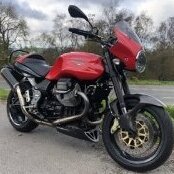-
Posts
435 -
Joined
-
Last visited
-
Days Won
5
Weegie last won the day on August 18 2021
Weegie had the most liked content!
About Weegie
- Birthday July 11
Profile Information
-
Location
Scotland
-
My bike(s)
98 Magni Australia, 92 Magni Sfida 1000, 99 Magni Sfida 1100, 2017 BMW R9T Racer
Recent Profile Visitors
3,215 profile views
Weegie's Achievements

Forum-aholic (3/5)
590
Reputation
-
Interesting that it has a MotoSpezial V Sump (Guzziladen was still selling these last I heard) Installing one onto a Broadsump isn't straightforward and unless provision is made for an oil cooler, of doubtful gain in cooling. Paul Minnaert is the only guy who installed one onto a Daytona that I knew of, but there are obviously more out there Paul installed a cooler using a sandwich plate behind the oil filter to feed a cooler. I thought about a similar setup but the deepsump wouldn't fit as mine has a bellypan. Suppose the external filter is a gain and the Vee reduces the chance of pump pickup starvation, but a Roper Plate does much the same thing. @HadaDaytona are you going for a US Daytona RS? I think the US Daytona RS and the Centi engines are the same. European bikes got "absolutely mad" C kit cams which make them enormous fun, but they run hot (100 C in free air) and overheat very quickly in traffic. More suited to a track than the road. EDIT For clarity the C kit cams were only installed to the Daytona RS exceptions being Dayona RS imported to Switzerland, Singapore and the US. The exceptions had the original Daytona cams. The Centauros sold everywhere had the original Daytona cams too.
-
Couldn't agree more with @GuzziMoto sentiments I use CRG Arrow mirrors on my bikes, I only use one mounted on the Offside. https://constructorsrg.com/mirrors/arrow.html Find them superior to stock mirrors, improved looks, don't vibrate and give me clear wide view behind (the mirror is convex glass). Glance down and I know what's behind me, they fold in towards the bar easily for tight lane splitting when required. Word of advice if you're thinking about them. Many cheap copies out there and the originals are relatively expensive. The cheapies are garbage, purchase the CRG originals or don't bother (don't ask me how I know).
-

1992-1996 Daytona Seat Fairing Builders Review Request
Weegie replied to HadaDaytona's topic in Older models
Agree, the original seat design is far superior to either the Sport or the RS, but that's just my opinion Only thing I can add is the original was one piece with no seam, as I recall. The rear would require cutting at the base to accomodate a tail light, if you were mimicking the orignal design -
@audiomick nope missing nothing at all on operation, that's my understanding too. I'm also reading your interpretation of the OP's symtoms as correct, not unusual to become confused on how the switch functions I once experienced a short after washing my (now sold) Daytona and the low pressure light stayed on after starting, rather quickened my pulse at the time.
-
I understand your point but forgive me, I think you missed mine. You are of course correct that the switch and its associated dash warning has zero impact on engine function or health It doesn't stop switching the fuel light AFAIK but illuminates the dedicated low oil pressure warning light BUT If it illuminates when out on a ride, how can you tell if the fault is with the switch or the system? Without any verification it would take a braver rider than me to ignore the warning and just ride on and if you do then what's the point of the warning light in the first place? The 2 v/v engine's oil system is very reliable (the most common problems have already been pointed out by @gstallons ). One thing that shocked me about the BMW R9T I own, it has no low oil pressure warning whatsoever
-
The oil pressure switch doesn't have a particularly good reputation when it comes to reliability. That said failure rate is probably low overall, if you consider all the models that run that switch. It was in use for a very long time The question is what do you do if out on a ride and the switch decides to fail? I'd immediately kill the engine and coast to halt, hoping there was somewhere in the vicinity I could get the bike safely off the road. At best that would leave me stranded or a very long wait for a recovery service to rescue me. I've no empirical evidence, but have been told you probably have a minute or two before the engine will incur serious damage. Call me over cautious but I'd also be freaking out at the possibility of engine seizure. Many advocate against installing a pressure gauge, I did and this was one of the scenarios I envisaged. I also installed an aftermarket switch which I teed off from the gauge line. The probability of this event occurring is very low, it's just one of these things that I'm OCD about I'll get ma coat
-
Thank's @docc Good with me and if it helps the forum or other members then all the better. Do I need to do anything, let me know? I'll just keep the diagrams in my Dropbox, don't anticipate any problems with them residing there as it isn't something I use much anyway. Should you want to rehouse them that's also fine.
- 5 replies
-
- 2
-

-
- kiwi_roy
- carl allison
-
(and 1 more)
Tagged with:
-
Surprised nobody has mentioned Carl Allison's schematics, I've found them pretty good, occassionally they have the odd error, but overall very easy to read. The factory wiring diagrams are pretty difficult to follow, at least for me Available on This Old Tractor, Gregg Bender's site https://www.thisoldtractor.com/guzzi007/sportissimo.html I'm taking a chance here but as @Kiwi_Roy seems to have gone Off Grid, I've dumped what schematics I have of his onto Drop Box in case anybody would like to grab them. I'm pretty sure he won't mind https://www.dropbox.com/scl/fo/no8adkie1sl6frnc2qmm8/ALzrUXsngCqMRtfMR1cXedE?rlkey=8x5byzd4ux3107610i22ig5v6&st=3xbx7rbu&dl=0
- 5 replies
-
- 4
-

-

-
- kiwi_roy
- carl allison
-
(and 1 more)
Tagged with:
-
Lots of different flavours available, not only manufacturer but type. I have a similar mod on one of mine, now redundant as a H4 LED bulb is installed. I just used some spare Panasonic mini relays I had to hand (similar in size and form factor as the OEM relays on the bike). As long as they are 12V and 20A or greater current capacity with a normally open contact they'll be more than up to the job. Diodes on the relay coils shouldn't be necessary for the application. What I would do is what @audiomick already suggested and purchase not only relays but also bases. Makes the job neater, the terminals more secure and if anything went wrong a damm site easier to change out.
-

BMW R12S 2025 in Orange; nice!
Weegie replied to p6x's topic in Special place for banter and conversation
I've got an 2017 R9T Racer, picked it up about 3 years back for £7k with less than 3k miles, thought it wasn't a bad deal So far I've had no problems and really like it, good linear midrange, but IMHO they aren't as engaging as the Guzzis, a little less soul. The stock suspension is pretty dire, replaced the rear shock with a Wilbers unit and an Ohlins cartridge kit in the forks, transformed the bike The other thing I miss is the exhaust note, I've got a Zard on mine, so it's louder than stock, but the exhaust note is flat and monotone. The riding position on the Racer is pretty extreme, radical clip ons and stretched over the tank. That doesn't appear to be the case though with the R12 I know nothing of the R12S but I do really like the looks, the grumblings on the Beemer forum I'm on is mainly the price. A few have purchased one, but yet to see an owner's report. My Racer, its beem modified a little since the pictures, nothing too radical though -
To the best of my knowledge the low level fuel warning "transmitter" is an NTC thermistor. That's why the lamp glows before full brightness, avalanche effect of the current increase causing further heating and lowering circuit resistance further I've no clue on quantitative resistance values. Could the backfeed not find a path to ground on the Hi Beam Relay through the Hi Beam bulb? Coil resistance in the relay could easily drop the voltage sufficiently that the bulb won't light but still provide a path to ground. I know Guzzi used a similar scheme on the single indicator dash warning lamp on some models. The indicator warning light grounds through the indicator bulbs on the opposite side selected. Personally I wouldn't bother, the scheme is now working as intended. Chasing grounds could take forever and result in finding nothing Hell I still don't even know if I'm using the correct wiring diagram.
-
The bar switch provides positive voltage when the beam is selected I think the Lo Beam relay is wired correctly (although why he wired back to the battery on the coil side seems OTT) The Hi Beam has a Positive from the battery (85) and (86) is wired to the bar switch, this where things go awry and probably accounts for the wierd behaviour of the beams with ignition Off. The battery will be backfeeding positive voltage into the switch (it won't do any harm but probably result in wierd behavour). The Hi Beam Green wire to (85) should be connected to battery negative I apologise to @audiomick if that's what he stated in the previous posts, I just couldn't understand, which says more about me than him You could wait for another member to confirm, no harm on a second opinion
-

new reg, new stator, new battery, still poor charge
Weegie replied to LaGrasta's topic in Technical Topics
Doesn't sound like the battery then Usual check on the Alternator is to measure the output wire with a multimeter set to AC Volts Figures are in the manual I believe, if the same as the Sporti they are 15 V AC @ 1k RPM 40 V AC @ 3k RPM 80 V AC @ 6k RPM I'm not ruling it out but still leaning toward something amiss in the system wiring or the Reg/Rec One other thing that intrigued me, it looked like the Reg/Rec was for a 3 phase Alternator, that's fine its just 2 of the phases aren't used. Oh and the manual also has current figures for the system, looks like it's meant to max out at a little over 27A Where's @Kiwi_Roy when you need him? -

new reg, new stator, new battery, still poor charge
Weegie replied to LaGrasta's topic in Technical Topics
I'm not quite sure I understand, you state poor charge then say a 30A breaker is tripping often? I'm unaware of this mod but guessing it's replacing fuse 3 on the output from the charge circuit to the battery. If it's tripping at 30A then sounds to me like the Alternator is doing its job, but system voltage isn't rising above 13.0 V. Could be a short, but I'd have thought you'd find that quickly either through blown fuses or smoke. Obvious start fully charge the battery with an exeternal charger then let it rest for a few hours and check the float voltage. Battery acts like an accumulator (or resevoir), if its voltage is low it can drag down system voltage and although a long shot it wouldn't be the first new battery that's been found defective Next thing after that would be to check battery voltage not being dragged down by parasitic load or small leakage. So the battery is low when you set out and will take time to rise in voltage. I'd also shoot a mail to Electrosport and ask them what the RR output voltage is set to as well, 13.0 volts sounds a tad low to me too, I'd think 13.5-14.0 volts is where it should be. It isn't catastrophic IMHO but is a bit low. EDIT Just to add I'm ASS-uming the rectifier ground/earth/chassis is good and of course battery ground, poor grounding usually results in higher system volts AFAIK, but it may be worth checking. Brighter minds will chip in soon (I hope) -
Feel free to ignore, but looking at the pictures I haven't a clue what the PO intended Rather than swapping wires around on the relays would it not be better to get some clue about the scheme? I'd try to identify where the sources of the wires at the relay pins eminate from, identify them and sketch a diagram, to provide a starting point. Possibly a source from the battery at each relay, ground(s), an input from the switch and one to the beams for each relay. I'd also note any jumper wires on the relays and any wires which go from one relay to the other. If the source points can be located, mistakes can be rectified, modified or a new scheme made to work. I'm going to try and resist posting further as the last thing you need on this is another "cook to spoil the broth"



